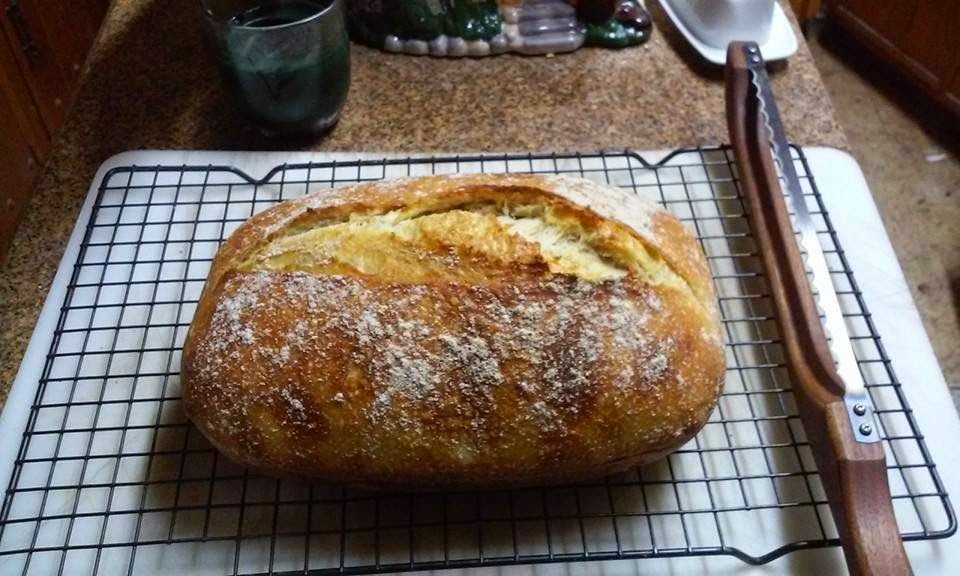With temps dropping along with the leaves I figured it was time to fire up another starter and get ready for the coming indoor baking season. The starter I chose to use this time is a Sourdough International San Francisco starter. I started with a dried back up and spent the last week feeding and nurturing it back to life. Today it was time to do something with it. Below is the recipe I'm creating today.
Ingredients
350g white flour
260g active starter
60g whole wheat flour
30g fresh milled rye flour
25g fresh milled spelt flour
25g fresh milled buckwheat flour
13g Tuscan herb salt
1 sprig fresh chopped rosemary
1 clove fermented garlic chopped fine
292g water - room temp
Prepare the dough
1. At least 12 hours before beginning (you can do this the night before), feed starter as follows: Remove
starter from refrigerator and add equal parts flour and room-temperature water (I use about 130 g each,
which replenishes what I'll be using in the bread). Stir/whip well, incorporating oxygen, and leave on
the counter top, with the cover slightly ajar. Starter should be bubbling and lively when you begin your
bread.
2. Place a large bowl on your scale and zero out the scale. Now add the flours, one at a time, zeroing
out the scale after each addition. Add the starter and the water.
3. Mix thoroughly with a wet hand until the dough is homogeneous. Mist a piece of plastic wrap with
vegetable oil spray, press it directly onto the dough, and leave the dough to autolyse for 45-60 minutes.
Kneading and fermentation
4. Remove dough from bowl and flatten out on the kneading surface. Add salt, chopped rosemary and chopped garlic and knead by hand 7-9 minutes. You can use a stand mixer with a dough hook for 2-3 minutes if you like but it takes away the joy of working the dough by hand. Knead until dough is elastic and smooth.
5. Clean out and dry the mixing bowl (no soap), mist with vegetable oil spray, and replace the dough.
Place the oiled plastic wrap back onto the dough. Ferment at room temperature (68 -72 degrees is ideal)
for 4 to 5 hours.
Form and proof the boule
6. Using your hand or a flexible pastry scraper, remove the dough to a floured counter top.
7. Gently press down to form a disk about an inch thick. Try not to press out the gas bubbles or mess
with it too much.
8. Fold the edges into the center. Move around the disk several times, pulling and gathering, tighter and
tighter, trying to create some surface tension, as you form a ball. Finish with a just few seconds of half-
rolling, half-dragging across the floured counter top, moving the boule in a tight circular motion.
9. If you don't have a banneton or basket for proofing boules, simply line a kitchen colander with a
well-floured linen napkin and place the boule inside, seam side up.
10. Cover with same piece of plastic wrap and set aside to proof, 11⁄2 to 2 hours. While dough is
proofing, place a cast iron dutch oven with the lid on it on the bottom shelf of the oven. Preheat oven to its highest setting.
Score and bake
11. After 1 1/2 to 2 hours, when the dough is proofed (another term for the second rise), it should
have increased in volume by about half, and feel slightly springy. Remove the plastic wrap and sprinkle with rice flour or corn meal. Open the oven and setting the lid to the dutch oven aside, grasp the basket and flip the dough into the hot dutch oven. Be careful not to burn yourself.
12. Make several symmetrical slashes (or grignes) with your lame or razor. A "tic-tac-toe" grid is a
good way for beginners to start.
13. Immediately spritz the top of the loaf with water from a spray bottle and put the lid back on the dutch oven. Try to minimize the time the oven door is open.
14. Set oven temperature to 480 degrees F.
15. After 20-25 minutes, remove the lid from the dutch oven.
16. Bake until loaves register 210 degrees F in center, about 50 to 60 minutes) with an instant-read
thermometer.
17. Return bread to oven, with oven off and door closed, for 10 to 15 minutes.
18. Remove bread to a rack and cool for at least 2 hours before serving.
The finished loaf.
I'll take this one to work Monday and share it with my co-workers.

